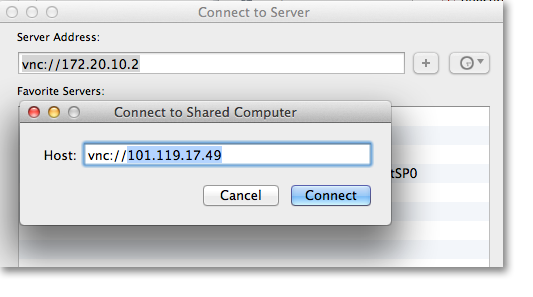

- #Setup vnc for mac how to
- #Setup vnc for mac install
- #Setup vnc for mac password
- #Setup vnc for mac mac
#Setup vnc for mac mac
Set up Screen Sharing (VNC) service on the office Mac You need skeys or TOTP, but not X-windows or other features that SSH offers. Set up 2FA as per the instructions in the Connect with Screen Sharing app (VNC client)įind out the network name of your office Mac: usually something like.Set up Screen Sharing (VNC) service on the office Mac.When done, close your Screen Sharing app, then you can log out of run the Screen Sharing app and access the office Mac.run ssh and log in to dora, and (while ssh is running).set up Screen Sharing on your office Mac.Įach time you want to connect to your office Mac, you need to:.set up 2FA security on your Maths login account, and.On MacOSX: work as if you were sitting in front of your office Mac.
#Setup vnc for mac how to
How to access your Maths office Mac from an "outside" (home or You will be prompted to enter the user password.ĭo not forget to replace username and server_ip_address with your username and the IP address of your server.VNC howto How to use Apple Screen Sharing (VNC) with 2FA If you run Linux, macOS, or any other Unix-based operating system on your machine, you can easily create a tunnel using the following sshĬommand: ssh -L 5901:127.0.0.1:5901 -N -f -l username remote_server_ip Set Up SSH Tunneling on Linux and macOS # To securely forward traffic from your local machine on port 5901 to the remote server on the same port. The recommended approach is to create an SSH tunnel VNC is not an encrypted protocol and can be subject to packet sniffing. To enable VNC for other users, simply replace 1 with the display port mapped to the user. Loaded: loaded enabled vendor preset: disabled)Īctive: active (running) since Thu 21:49:41 UTC 8s ago You can verify that the service is successfully started with: sudo systemctl status The VNC server will listen on port 5901, as we discussed in the previous section. To start and enable the VNC service for the user mapped to the display port :1, enter: sudo systemctl enable -now Once you’re done with the configuration, the last step is to start the VNC server. What is important to understand is that when working with VNC servers, :X is a display port that refers to 5900+X. If you map another user, for example, to display port :2, the server will also listen on port 5902 (5900+2).

In our case, the server is running on TCP port 5901 (5900+1). :1 is the display port number on which the VNC server will run. # TigerVNC User assignment # This file assigns users to specific VNC display numbers. Open the file and add the following: vim ~/.vnc/config VNC reads the user configuration settings from the ~/.vnc/config file. The next step is to configure TigerVNC to use Gnome. If you’re adding a second user, switch to it
#Setup vnc for mac password
Would you like to enter a view-only password (y/n)? n The first time the vncpasswd command is run, it will create and store the password file in the user’s ~/.vnc directory. If you choose to set up a view-only password, the user will not be able to interact with the VNC instance with the mouse and the keyboard. You will be prompted to enter and confirm the password and whether to set it as a view-only password. Run the command as the user that will access the VNC server, do not use sudo: vncpasswd Use the vncpasswd command to set up the password. In this example, we’ll show you how to configure TigerVNC for one or more VNC users. In CentOS 8, TigerVNC is configured using the systemd daemon.
#Setup vnc for mac install
To install it, type: sudo dnf install tigervnc-server Configuring VNC Server # It is available in the default CentOS repositories. Is an actively maintained high-performance open-source VNC server. Run the following command to install Gnome, the default desktop environment in CentOS 8 on your remote machine: sudo dnf groupinstall "Server with GUI"ĭepending on your system, downloading and installing the Gnome packages and dependencies may take some time. If the machine you want to connect to doesn’t have GUI, the first step is to install it. Generally, servers don’t have a desktop environment installed. To follow this guide, you need to be logged in as a user with sudo privileges We’ll also show you how to securely connect to the VNC server through an SSH tunnel. This article covers the steps to install and configure a VNC server on CentOS 8. Virtual Network Computing (VNC) is a graphical desktop sharing system that allows you to use your keyboard and mouse to remotely control another computer.


 0 kommentar(er)
0 kommentar(er)
